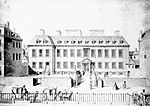Wyld's Great Globe (also known as Wyld's Globe or Wyld's Monster Globe) was an attraction situated in London's Leicester Square between 1851 and 1862, constructed by James Wyld (1812–1887), a distinguished mapmaker and former Member of Parliament for Bodmin.
At the centre of a purpose-built hall was a giant globe, 60 feet 4 inches (18.39 m) in diameter. The globe was hollow and contained a staircase and elevated platforms which members of the public could climb in order to view the surface of the earth on its concave interior, modelled in plaster of Paris, complete with mountain ranges and rivers all to scale. Punch described the attraction as "a geographical globule which the mind can take in at one swallow." In the surrounding galleries were displays of Wyld's maps, globes and surveying equipment.
Wyld originally proposed that the globe should be constructed at the Great Exhibition, but its size and Wyld's desire to run it as a promotional venture precluded it from being featured inside the Crystal Palace, so Wyld negotiated with the owners of the gardens of Leicester Square, and after much wrangling secured an agreement to site it there for ten years. The exhibition hall and model of the Earth were hastily constructed to coincide with the Great Exhibition.
In its first year the Great Globe was a resounding success, with visitor numbers second only to those of the Great Exhibition, but from 1852 onward public interest in the attraction slowly waned. Though the novelty of a concave globe continued to win accolades for Wyld, he was faced with competition from other educational attractions, and had to adapt the entertainments on offer in order to maintain visitor numbers. Wyld held topical exhibitions and gave lectures on current events, and attempted to transfer ownership of the attraction to the "Cosmos Institute" to establish a national geographic and ethnological museum. In 1862, when Wyld's agreement for the use of the land expired, the exhibition hall was removed and the globe broken up and sold for scrap. The complicated ownership of Leicester Square gardens, combined with Wyld's failure to honour his agreement to restore the gardens after the removal of the exhibition building, led to extensive legal wrangling and questions in Parliament. Wyld finally sold his interests in the gardens, and in 1874 they were donated to the City of London.
Although there were other proposals for giant globes, and a few were constructed, it was not until 1935 that a large concave globe was recreated in the form of Chester Lindsay Churchill's Mapparium at the Mary Baker Eddy Library in Boston, Massachusetts.








